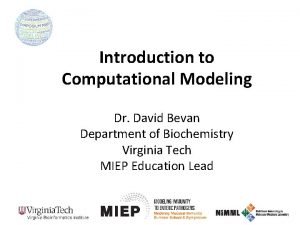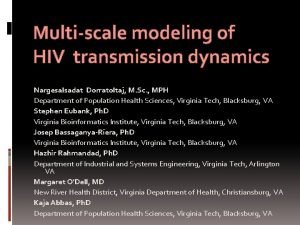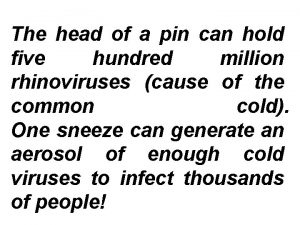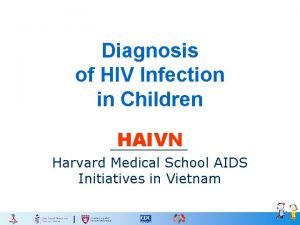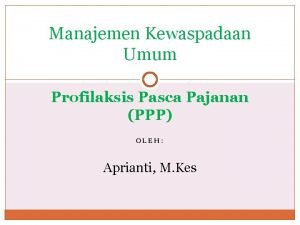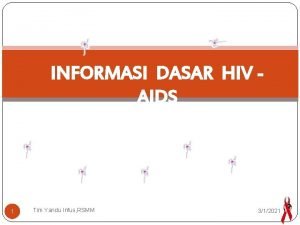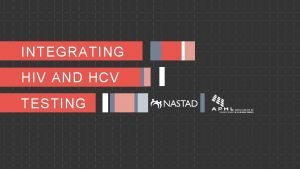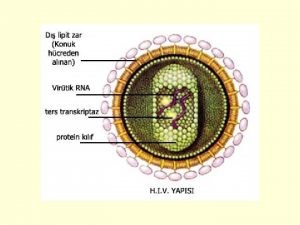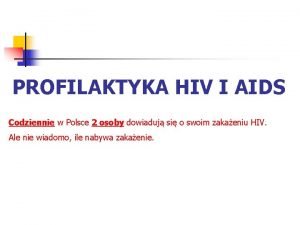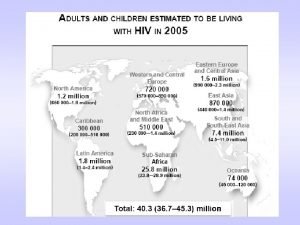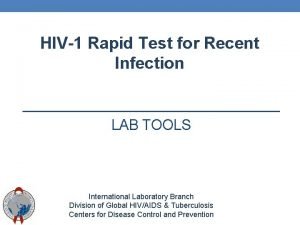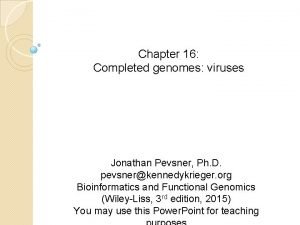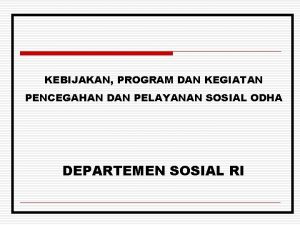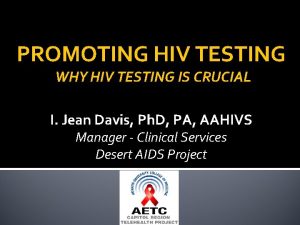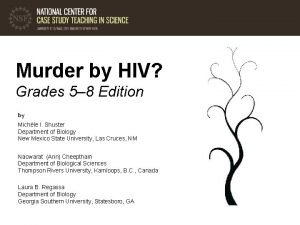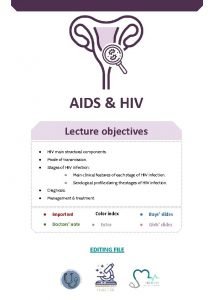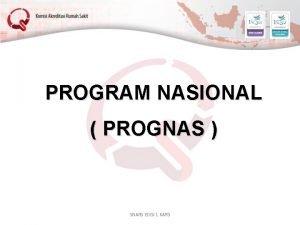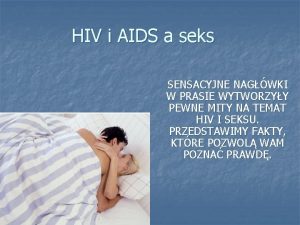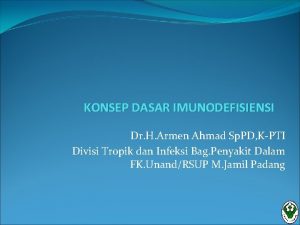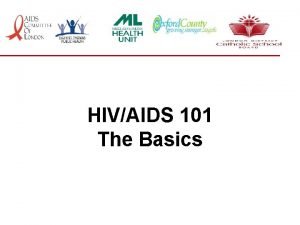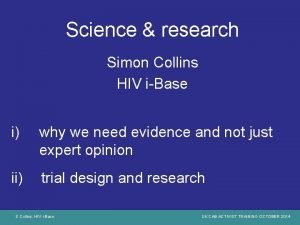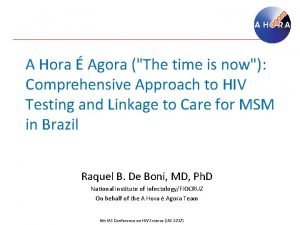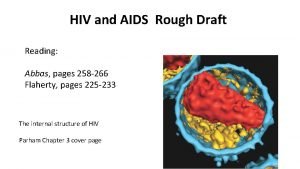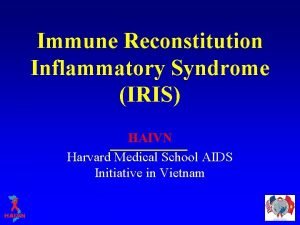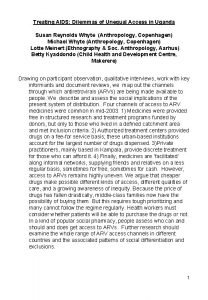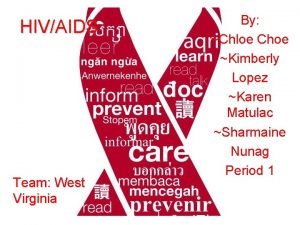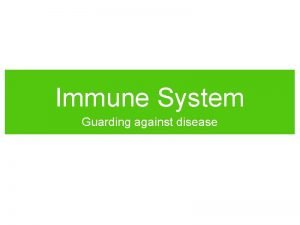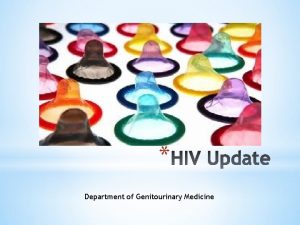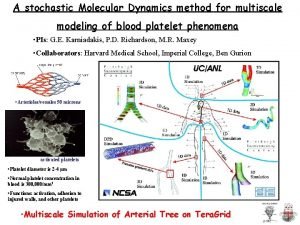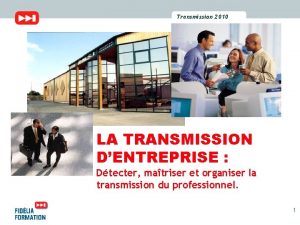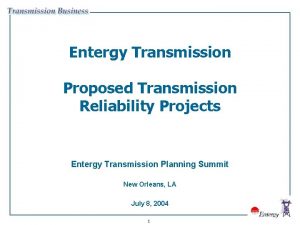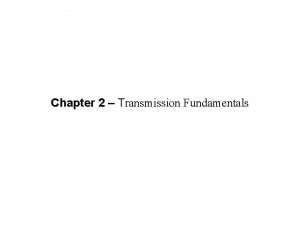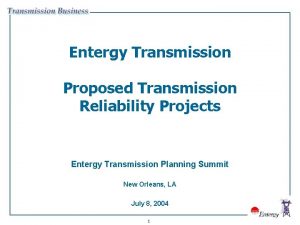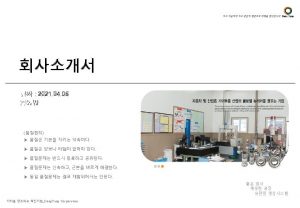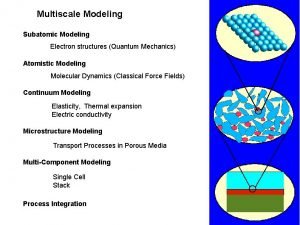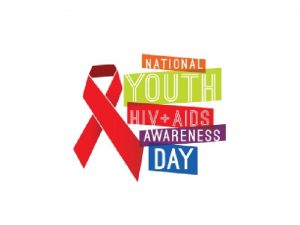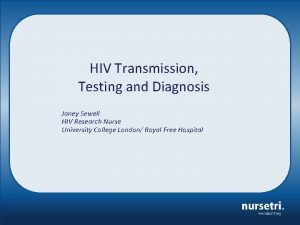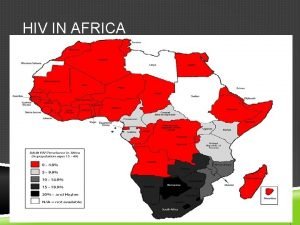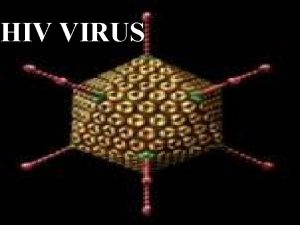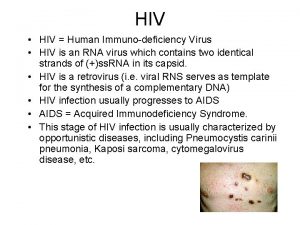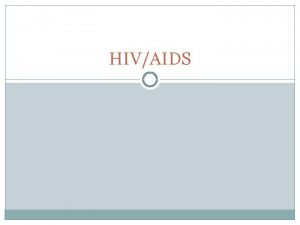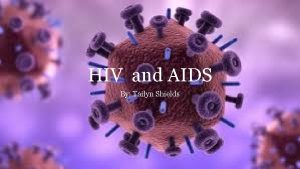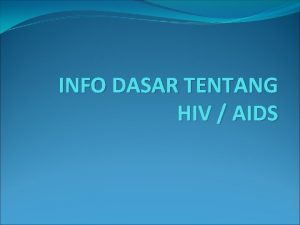Multiscale modeling of HIV transmission dynamics Nargesalsadat Dorratoltaj








































- Slides: 40

Multi-scale modeling of HIV transmission dynamics Nargesalsadat Dorratoltaj, M. Sc. , MPH Department of Population Health Sciences, Virginia Tech, Blacksburg, VA Stephen Eubank, Ph. D Virginia Bioinformatics Institute, Virginia Tech, Blacksburg, VA Josep Bassaganya-Riera, Ph. D Virginia Bioinformatics Institute, Virginia Tech, Blacksburg, VA Hazhir Rahmandad, Ph. D Department of Industrial and Systems Engineering, Virginia Tech, Arlington VA Margaret O'Dell, MD New River Health District, Virginia Department of Health, Christiansburg, VA Kaja Abbas, Ph. D Department of Population Health Sciences, Virginia Tech, Blacksburg, VA

Conflict of Interest: None We declare that we have no conflict of interest, and we comply with the American Public Health Association Conflict of Interest and Commercial Support Guidelines.

Learning objectives • Formulate and analyze the within host transmission dynamics of HIV using differential equations. • Design and analyze the between host transmission dynamics of HIV using a network model. • Design a multiscale model connecting the within host transmission dynamics and between host transmission dynamics of HIV.

Study Objective

Study Objective Develop a multi-scale immunoepidemiological model of HIV with focus on the impact of antiretroviral treatment interruptions: Understand the within host HIV viral and immune dynamics at the individual level Understand the epidemiological dynamics of HIV transmission in the population Connect the individual level model to the epidemiological level and build a multi-scale model of HIV transmission and dynamics.

Background

Human Immunodeficiency Virus (HIV) • HIV is a lentivirus (a subgroup of retrovirus). • The primary target of HIV are helper T cells, Macrophages, and dendritic cells. • It causes acquired immunodeficiency syndrome (AIDS), which tends to progressive failure of the immune system. • AIDS allows opportunistic infections and cancers to thrive. • Transmission happens through blood, semen, vaginal fluid, or breast milk. • Without treatment, the average survival time is 9 to 11 years after infection.

Global epidemiology of HIV

HIV/AIDS treatment: Highly Active Antiretroviral Therapy (HAART) First introduced in 1996 with focus on the effect of combinational therapy for HIV treatment Kumar and Herbein, 2014, Molecular and Cellular Therapies

Highly Active Antiretroviral Therapy (HAART) coverage

Highly Active Antiretroviral Therapy (HAART) • Benefits: A milestone in HIV treatment, Causes significant decline in mortality among HIV+ patients. • Risks and problems: Drug resistance Treatment fatigue Drug toxicity Adherence issues High cost Life style issues Different studies show that 6 to 51% of HIV-positive patients interrupt their treatment because of the following reasons: • • Forgetting Traveling Nausea and vomiting Running out of pills Losing or misplacing pills No confidence in effectiveness of pills Or simply because: They feel well

Periodic treatment interruptions: A possible solution for HAART adverse effects Benefits Risks • To control HAART adverse effects • Viral rebounds • To let the HIV wild type emerge • To improve drug adherence • Increased person to person transmission • Increased risk of opportunistic co-infection Since 2003, different studies reported conflicting results: Staccato 2003 SMART 2006 LOTTI 2009 Other smaller studies…

Public Health Significance • Currently, there are no good explanations for the clinical differences of previous studies. • We suggest mathematical models as a less expensive method to predict HIV treatment interruption impacts within host. • Mathematical models can prevent harmful clinical trails. They can help experimentalists in optimizing criteria selection. • Choosing the correct threshold can be crucial to prevent adverse effects of long term treatment and its interruption.

Immunoepidemiological model • Immunoepidemiology: Immunoepidemiology studies the combined effect of the immunological dynamics at the individual levels and the epidemiological dynamics at the population level. • Immunology: Immunological models analyze the within host dynamics between HIV virus, uninfected CD 4+ T Cells, and Infected CD 4+ T Cells. • Epidemiology: Epidemiological models, analyze the transmission dynamics between Susceptible, and Infected individuals during the acute, latent, and late stages of HIV. • What have been done so far? Within and among host scales have been studied separately. • Where is the knowledge gap? Understanding HIV dynamics occurring across scales by developing multi-scale modeling is significant and novel. /11 14

Methods 1. Within host model of HIV immune-viral dynamics 2. Between host model of HIV transmission in the population

Methods 1. Within host model of HIV immune-viral dynamics 2. Between host model of HIV transmission in the population

Conceptual framework of HIV dynamics within host

HIV dynamics within host: Mathematical model Parameter symbol Description Value Range Unit Reference Uninfected T cell birth rate 10 (5, 36) mm-3 day-1 Krischner and Perelson (1995) HIV transmission rate 4. 57 x 10 -5 (10 -8, 10 -2) mm 3 day-1 Hadjiandrea et al (2007) Uninfected T cell death rate 0. 01 (0. 01, 0. 02) day-1 Hadjiandrea et al (2007) Infected cell death rate 0. 4 (0. 24, 0. 7) day-1 Krischner and Perelson (1995) Virus production rate 45 (37, 500) day-1 Hadjiandrea et al (2007) Virus clearance rate 2. 4 (2. 4, 50) day-1 Hadjiandrea et al (2007)

Adding treatment to the model Kumar and Herbein, 2014, Molecular and Cellular Therapies

Methods 1. Within host model of HIV immune-viral dynamics 2. Between host model of HIV transmission in the population

A network model to simulate the sexual partnership Network Characteristics: People(Nodes) characteristics: �Sex �Age �# of partnerships (edges) �Time to HAART initiation after HIV transmission �Co-infection? Partnership (Edges) characteristics: �Type( Spousal or Non-spousal) Heterosexual partnership (Bipartite) Chance of HIV transmission from male to female equals the chance of transmission from female to male ( Not-directed)

Exponential family random graph model (ERGM) to predict the probability of a partnership Why? Social networks are more clustered than random networks �Homophily (People choose partners who are like them) �Transitivity (Friend of a friend) ERGM is general and flexible How? Predict the probability of a partnership(edge) based on network statistics: �Total number of edges �Number of males and females in a monogamy or concurrent partnership (2 partnership)

Results 1. Within host model of HIV immune-viral dynamics 2. Between host model of HIV transmission in the population

Results 1. Within host model of HIV immune-viral dynamics 2. Between host model of HIV transmission in the population

HIV dynamics with no treatment CD 4 cell steady state : 455 cells per microliter Viral load steady state: 261, 950 copies per ml

HIV dynamics with combination treatment Antiretroviral therapy is initiated at day=700 after HIV transmission.

HIV dynamics during time-based treatment interruptions Treatment interruption periods: 200 days

HIV dynamics during time-based treatment interruptions 100 days interruption periods 30 days interruption periods

HIV dynamics during adaptive periodic treatment interruptions

HIV dynamics during adaptive periodic treatment interruptions

Results 1. Within host model of HIV immune-viral dynamics 2. Between host model of HIV transmission in the population

Fitted network model

Discussion

Summary • HIV-positive patients may interrupt their treatment because of treatment fatigue or adverse effects. • Currently, there is no good explanation on how patients can go on treatment interruption without experiencing any harm. • Periodic treatment interruption can be an option to assist patients. • Mathematical models can help us recommend feasible strategies for treatment interruption.

Public Health Implications: More effective interruption threshold for future clinical trials. Less/non-harmful HAART interruption periods.

Limitations “All models are wrong, but some are useful. “ George E. P. Box • Simplified immune system (No CTL, Macrophage, Dendritic cells). • No suggestion for the acute or AIDS stages. • Treatment causes full CD 4 recovery and virus elimination, without considering latent infection. • …

Future work • Add effects of other immune cells to the model. • Validate within host model with real world data. • Simulate the impact of treatment interruption on HIV transmission in the population. • Apply the results of within host and between host models to build an immunoepidemiological model of HIV treatment interruption.

References 1. 2. 3. 4. 5. 6. 7. 8. 9. 10. 11. 12. 13. 14. 15. 16. Ananworanich, J. , Nuesch, R. , Le Braz, M. , Chetchotisakd, P. , Vibhagool, A. , Wicharuk, S. , . . . Swiss HIV Cohort Study (2003). Failures of 1 week on, 1 week o antiretroviral therapies in a randomized trial. , 17 (15), F 33{37. doi: 10. 1097/01. aids. 0000088241. 55968. 65 Carr, A. , & Cooper, D. A. (2000). Adverse eects of antiretro-viral therapy. , 356 (9239), 1423{1430. Retrieved 2014 -10 -26, from http: //www. sciencedirect. com/science/article/pii/S 0140673600028543 doi: 10. 1016/S 0140 -6736(00)02854 -3 Davey, R. T. , Bhat, N. , Yoder, C. , Chun, T. -W. , Metcalf, J. A. , Dewar, R. , . . . Lane, H. C. (1999). HIV-1 and t cell dynamics after interruption of highly active antiretroviral therapy (HAART) in patients with a history of sustained viral suppression. , 96 (26), 15109{15114. Retrieved 2014 -10 - 27, from http: //www. ncbi. nlm. nih. gov/pmc/articles/PMC 24781/ Di Mascio, M. , Ribeiro, R. M. , Markowitz, M. , Ho, D. D. , & Perelson, A. S. (2004). Modeling the long-term control of viremia in HIV-1 infected patients treated with antiretroviral therapy. , 188 (1), 47{62. Retrieved 2014 -10 -27, from http: //www. sciencedirect. com/science/article/pii/S 0025556403001305 doi: 10. 1016/j. mbs. 2003. 08. 003 Ho, D. D. , Neumann, A. U. , Perelson, A. S. , Chen, W. , Leonard, J. M. , & Markowitz, M. (1995). Rapid turnover of plasma virions and CD 4 lymphocytes in HIV-1 infection. , 373 (6510), 123{126. doi: 10. 1038/373123 a 0 Ledergerber, B. , Egger, M. , Opravil, M. , Telenti, A. , Hirschel, B. , Battegay, M. , . . . Weber, R. (1999). Clinical progression and virological failure on highly active antiretroviral therapy in Mag. HIV-1 patients: a prospective cohort study. swiss HIV cohort study. , 353 (9156), 863{868. Giolo, F. , Airoldi, M. , Callegaro, A. , Martinelli, C. , Dolara, A. , Bini, T. , . . . Suter, F. (2009). CD 4 cell-guided scheduled treatment interruptions in HIVinfected patients with sustained immunologic response to HAART. , 23 (7), 799{807. doi: 10. 1097/QAD. 0 b 013 e 328321 b 75 e Martinez, E. , Mocroft, A. , Garca-Viejo, M. A. , Perez-Cuevas, J. B. , Blanco, J. L. , Mallolas, J. , . . . Gatell, J. M. (2001). Risk of lipodystrophy in HIV-1 infected patients treated with proteaseinhibitors: a prospective cohort study. , 357 (9256), 592{598. doi: 10. 1016/S 0140 -6736(00)04056 -3 Mutwa, P. R. , Boer, K. R. , Rusine, J. , Muganga, N. , Tuyishimire, D. , Schuurman, R. , . . . Geelen, S. P. M. (2014). Long-term eectiveness of combination antiretroviral therapy and prevalence of HIV drug resistance in HIV-1 -infected children and adolescents in rwanda. , 33 (1), 63{69. doi: 10. 1097/INF. 0 b 013 e 31829 e 6 b 9 f O'Brien, M. E. , Clark, R. A. , Besch, C. L. , Myers, L. , & Kissinger, P. (2003). Patterns and correlates of discontinuation of the initial HAART regimen in an urban outpatient cohort. , 34 (4), 407{414. Pai, N. P. , Lawrence, J. , Reingold, A. L. , & Tulsky, J. P. (2006). Structured treatment interruptions (STI) in chronic unsuppressed HIV infection in adults. (3), CD 006148. doi: 10. 1002/14651858. CD 006148 Richman, D. D. , Morton, S. C. , Wrin, T. , Hellmann, N. , Berry, S. , Shapiro, M. F. , & Bozzette, S. A. (2004). The prevalence of antiretroviral drug resistance in the united states. , 18 (10), 1393{1401. Rodger, A. J. , Lodwick, R. , Schechter, M. , Deeks, S. , Amin, J. , Gilson, R. , . . . INSIGHT SMART, ESPRIT Study Groups (2013). Mortality in well controlled HIV in the continuous antiretroviral therapy arms of the SMART and ESPRIT trials compared with the general population. , 27 (6), 973{979. doi: 10. 1097/QAD. 0 b 013 e 32835 cae 9 c Smith, K. Y. (2002). Selected metabolic and morphologic complications associated with highly active antiretroviral therapy. , 185 Suppl 2 , S 123{127. doi: 10. 1086/340200 Strategies for Management of Antiretroviral Therapy (SMART) Study Group, El-Sadr, W. M. , Lundgren, J. D. , Neaton, J. D. , Gordin, F. , Abrams, D. , . . . Rappoport, C. (2006). CD 4+ count-guided interruption of antiretroviral treatment. , 355 (22), 2283{2296. doi: 10. 1056/NEJ- Moa 062360

Acknowledgements Stanca Ciupe, Ph. D Mathematics Department Virginia Tech Jessica M. Conway, Ph. D Department of Mathematics The Pennsylvania State University Public Health Program

THANK YOU Contact: Narges Dorratoltaj nargesd@vt. edu
 Eurofer
Eurofer Multiscale modeling
Multiscale modeling Dynamics
Dynamics Multiscale combinatorial grouping
Multiscale combinatorial grouping Helen c. erickson
Helen c. erickson Relational modeling vs dimensional modeling
Relational modeling vs dimensional modeling Cytomegalavirus
Cytomegalavirus Haivn
Haivn Profilaksis pasca pajanan hiv
Profilaksis pasca pajanan hiv Stadium hiv menurut who
Stadium hiv menurut who Brainpop
Brainpop Hiv test window period
Hiv test window period 4.jenerasyon vidas hıv duo ultra testi güvenilir mi
4.jenerasyon vidas hıv duo ultra testi güvenilir mi Procentowe ryzyko zakażenia hiv
Procentowe ryzyko zakażenia hiv Stakeholders in hiv prevention
Stakeholders in hiv prevention Triệu chứng nhiễm hiv
Triệu chứng nhiễm hiv Ciclo vitale hiv
Ciclo vitale hiv Asante hiv-1 rapid recency assay
Asante hiv-1 rapid recency assay Hiv siv
Hiv siv Kasus hiv aids
Kasus hiv aids Negative hiv test result
Negative hiv test result Murder by hiv
Murder by hiv Aids symptoms
Aids symptoms Incubation period of hiv
Incubation period of hiv Pokja program nasional
Pokja program nasional Procentowe ryzyko zakażenia hiv
Procentowe ryzyko zakażenia hiv Stadium hiv
Stadium hiv Aids 101
Aids 101 Simon collins hiv
Simon collins hiv Que hora é agora
Que hora é agora Chapter 25 sexually transmitted infections and hiv/aids
Chapter 25 sexually transmitted infections and hiv/aids Hiv
Hiv Hiv
Hiv Iris hiv
Iris hiv Hiv siv
Hiv siv Arv copenhagen
Arv copenhagen Igéje szól igéje hív
Igéje szól igéje hív Hiv
Hiv Hiv symptoms
Hiv symptoms Dot
Dot Hiv lifecycle
Hiv lifecycle

